What is a Software Firewall?
A software firewall can be described as a firewall in the software form that is deployed on the host system or server to comprehensively secure the network. It serves as a digital gatekeeper that safeguards the organization’s network from the internet and external devices filled with numerous threats.
The primary task is to assess, filter, and manage all the network traffic moving in and going out based on predefined security policies. It continuously monitors all the traffic and when it identifies any unauthorized and harmful traffic, it denies the passage, thus maintaining a defensive shield for the network-connected device.
From protecting data and workloads to applications and other digital assets, software firewalls make sure most of the assets in the network are secured from any kind of threat. They are highly useful in environments where it is impossible to deploy any kind of physical form of firewall.
This form of firewall is widely used on host systems, servers, endpoints, or company-owned laptops as they are always connected to the organization’s network. Even though cloud firewalls and next-gen firewalls are overpowering software firewalls but still serve as the effective choice for most enterprises.
How Does Software Firewall Work?
Software firewalls work in a similar fashion as firewall technology embedded in hardware firewalls where it acts as a barrier between the outer internet world and an organization’s private network. Unlike others, it operates in different layers of the system and can be deployed in different ways to cope with the needs of modern organizational requirements.
A unique capability of a software firewall is that it can be deployed into a cloud environment or virtual network. Besides, software firewalls are now being installed on IoT devices as they are widely connected to the network.
At first, software firewalls are installed on the host or server machine and they provide network administrators with the capability of granular network access decisions till the software level. The administrator can set up policies and controls that will block users from accessing malicious sites or any other dangerous site that doesn’t concern the business workflow.
It continuously monitors the traffic moving in and out of the business network to identify any malicious traffic or confidential data and restrict their movement. Security policies are set according to the network requirement and in most cases, only specific services related to business operations are allowed to pass through the firewall. However, all the outbound traffic is allowed to pass through the firewall except any traffic carrying sensitive data.
Features of Software Firewall
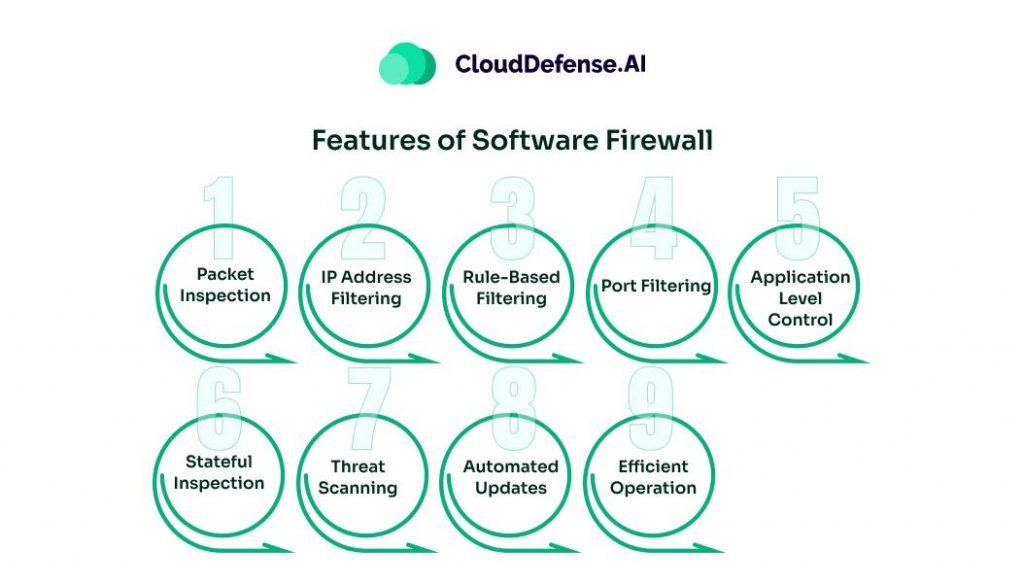
A software firewall is embedded with several vital features that work together to protect the network against all dangerous traffic. Here are some essential features that it offers:
Packet Inspection
Software firewalls are designed to inspect all the traffic that passes through and it mostly checks for malicious traffic which includes port data and superficial IP. Modern software firewalls involve deep packet inspection that utilizes state data to assess the payload content and find any malicious code or irregularities.
IP Address Filtering
IP address filtering helps software filter out all the unknown and potentially malicious identities and only enables approved IP addresses to move into the private network of the organization.
Rule-Based Filtering
Another crucial feature that defines software firewalls is rule-based filtering where moving packets are blocked or permitted to move in or out depending upon the rule. Usually, the rules are set by administrators according to the network and organizational requirements.
Port Filtering
Port filtering is a crucial security feature that allows certain ports to pass while restricting the movement of others. The passage of the port by the software firewall is determined by the data regarding the source and designation of the port.
Application Level Control
Application level control provides a firewall with granular control of different applications’ access to the main network of the organization. It makes the software firewall highly effective as administrators can regulate the complete network connection.
Stateful Inspection
Like deep packet inspection, stateful inspection also tracks the state and context of all the connections in the network. It then assesses the complete communication flow that ultimately helps in enhancing the overall network security.
Threat Scanning
Software firewall also offers threat scanning where it leverages intrusion detection systems to identify any potential threats and traffic causing policy violations. It works in coherence with traffic filters and ensures enhanced network security.
Automated Updates
Another great feature of software firewalls is that they can automatically update all the threat databases that enable advanced threat intelligence. It is highly effective to proactively identify malicious packets or potential threats.
Efficient Operation
A great thing about a software firewall is that it doesn’t consume many resources and operates on the host system like any other application. It has a limited computational and disk space requirement, making it an extremely efficient application.
Types of Software Firewalls
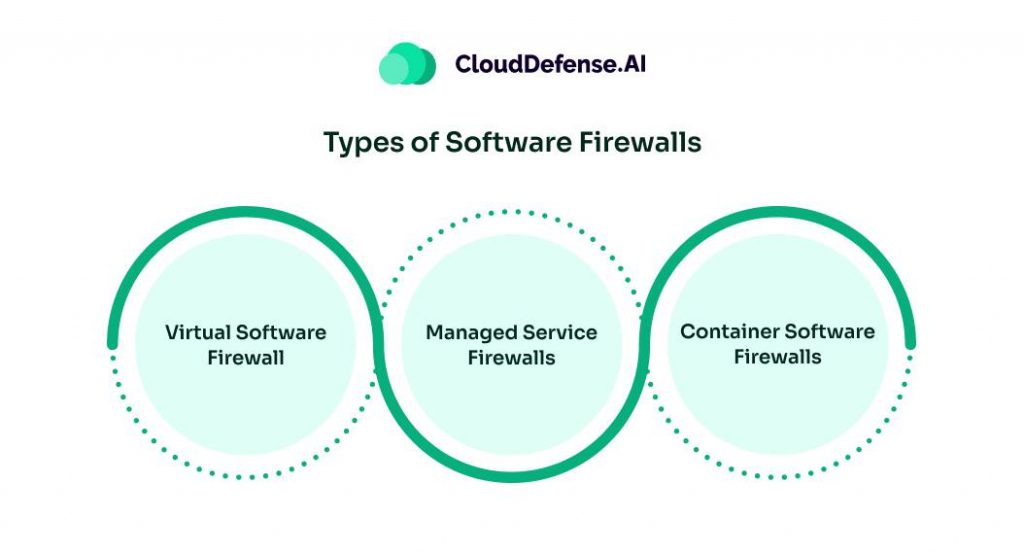
Software firewalls are segregated into three categories where each type caters to different security requirements and requirements. However, each type has the same primary function of monitoring and protecting all the network assets. Let’s take a look at all the types:
Virtual Software Firewall
Also known as cloud firewall, virtual software firewall is a popular type that is designed to manage the east-west traffic of branches and data centers, and assess and manage north-south traffic in public clouds. Thus it is widely used for protecting virtualized branches, 5G network deployments, hybrid clouds, private clouds, and public clouds.
When it is implemented in public clouds, it works to safeguard the cloud service provider and all the network connections vital to the cloud applications. It also includes microsegmentation that ultimately helps in advanced threat prevention.
Besides traditional virtual software firewalls, there are some advanced ones that enhance inbuilt security features for each CSP, maintain compliance with all industry regulations, and help businesses meet security obligations.
Managed Service Firewalls
A managed service firewall is a popular type of software firewall that shares many resemblances in terms of services of SaaS. As a result, this software firewall type is highly flexible and can be quickly scaled up and down depending on the security requirement.
A great benefit of this firewall type is that it offers the convenience of deploying application-level security without requiring the involvement of management oversight.
Container Software Firewalls
Container software firewalls are purpose-built firewall types that are designed to cater to Kubernetes environments. It works in a similar fashion as a virtual firewall but it is dedicated for a specific purpose.
Container software firewall offers security integration into the Kubernetes orchestration and helps in protecting the developers. Moreover, it eases up the process of securing container workloads which isn’t possible with traditional firewalls.
Benefits of Software Firewalls
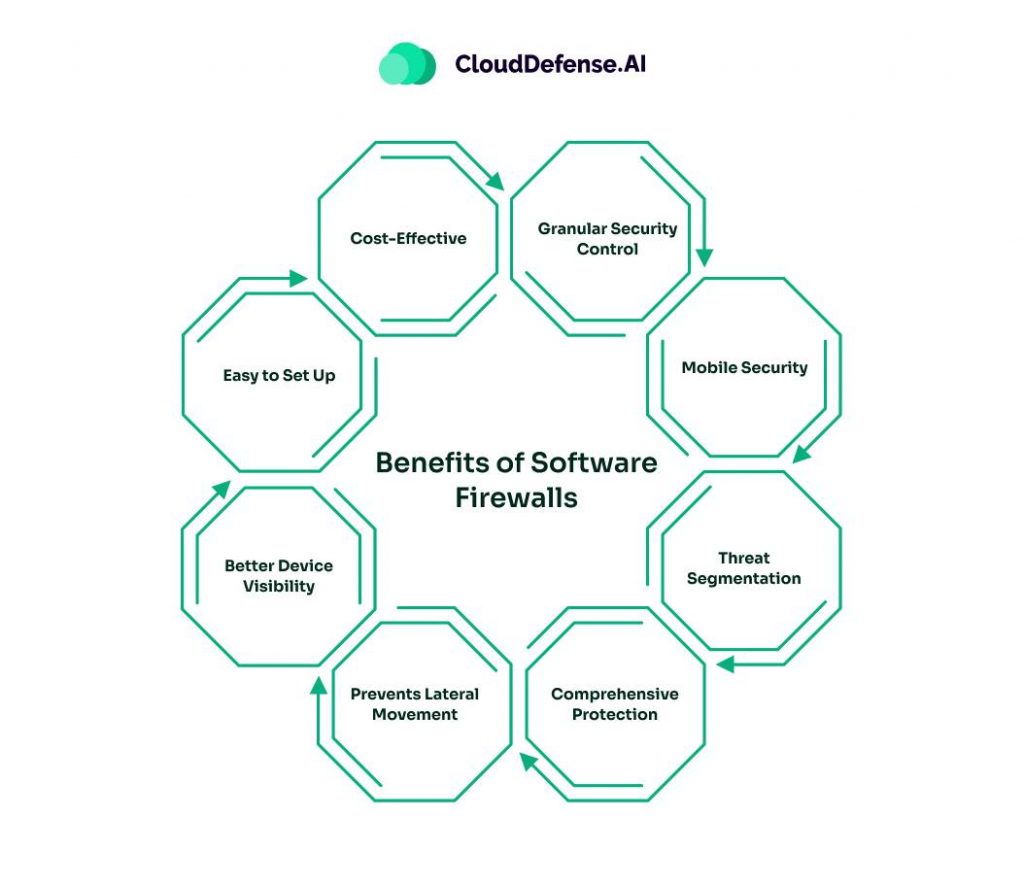
Even though next-gen firewalls and cloud-based firewalls are becoming popular among organizations, software firewalls still serve as a prominent solution due to numerous benefits. These benefits are:
Granular Security Control
When you implement a software firewall, it provides you with device-level and application-level control for both outgoing and incoming access. With this ability, the administrators can restrict the access of any dangerous program and device that might impact the network.
Specific policies can be set for different applications and devices and help in keeping sensitive information and resources with limited access.
Mobile Security
A great benefit of a software firewall is that it is completely mobile and can move with the device. It is highly useful for securing endpoints of users in the work-from-home model connected to the organization’s network.
Threat Segmentation
Another great benefit of software firewalls is threat segmentation which allows the security teams to segregate the firewall for each device connected to the network. When security compromises one device in the network, software firewalls isolate the threat and prevent it from spreading across the network.
Comprehensive Protection
Software firewall is known to establish comprehensive protection for all inbound and outbound network traffic. It provides security teams the ability to establish a secure and defined perimeter around the hybrid/multi-cloud environment at specific points.
In addition, it also effectively secures the outbound traffic as most modern applications use open-source or third-party code.
For software updates, these applications utilize repositories like GitHub, and a malicious update can be directed to an attacker’s command center. However, software firewalls prevent such misdirection by ensuring only necessary repositories should be accessed while preventing access to any unauthorized URLs.
Prevents Lateral Movement
All the cloud applications use APIs and other communication forms for communicating with the users and other devices outside the cloud. If there is a security breach, it can lead to lateral movement of the threat. However, software firewalls help prevent lateral movement and restrict their access to other applications and resources in the cloud.
Better Device Visibility
Software firewalls offer all the security team with a comprehensive visibility into all the network activity which can be helpful for identifying malicious traffic. Importantly, the visibility into all the network activity provides insight for endpoint detection and response solutions to mitigate any potential malware that can compromise the endpoint.
Easy to Set Up
Unlike hardware firewalls, software firewalls don’t require any tricky configuration and any user can install on the host or endpoint without going through any daunting setup process. Moreover in software firewall deployment and policy change are done automatically, thus preventing security teams from spending hours doing all the operations manually.
Cost-Effective
A highly useful benefit of using a software firewall is that it can be used by organizations of all sizes without having to make any hefty investment. Unlike hardware firewalls that require a lot of capital, software firewalls can be easily installed on any device or host system to secure the network.
Software vs Hardware Firewalls
Both software and hardware firewalls play a crucial role in protecting the network but they differ in many aspects. Even though core capabilities remain the same as what they control and feature they have some differences. Here is a detailed comparison of software vs hardware firewalls that will give you a clear idea of which one you will need:
| Software Firewall | Hardware Firewall | |
| Form Factor | Software firewalls are firewall programs that are installed on servers, systems, and virtual machines. They usually run on a generic hardware setup with a virtualization layer. | Hardware firewalls are physical devices that are configured between the primary host network and other connected devices. |
| Protection Level | Since software firewalls are installed on individual devices they provide granular protection and complete visibility into all the network activities. | Hardware firewalls are physically installed on physical elements so they provide overall protection to the network assets and devices. |
| Deployment Feasibility | It comes with different deployment options for specific hosts, servers, or machines. Security teams can deploy them as virtual, cloud, or container firewalls depending upon the network security. | Unlike software firewalls, hardware firewall comes with only one deployment option which is NGFW. |
| Installation Complexity | It is quite easy to deploy with the help of cloud automation tools. Moreover, it doesn’t require any expertise for deployment. | The security team has to go through a lot of complex tasks to accomplish the hardware deployment process. Skilled professionals are required during installation as it requires configuration through CLI. |
| Convenience | Software firewalls implement various security policies that can’t be easily bypassed. | Employees often bypass hardware firewalls to access certain restricted access and achieve faster connection. |
| Usability | It is quite easy to use and can be managed even by less experienced security staff. | Organizations require experienced and skilled security staff to manage any hardware firewall. |
| Affordability | The overall cost to deploy and maintain a software firewall is quite low. | Hardware firewalls require a lot of investment during installation. The organization also spends a decent amount of money on its maintenance and skilled employees. |
How to Choose the Right Software Firewall
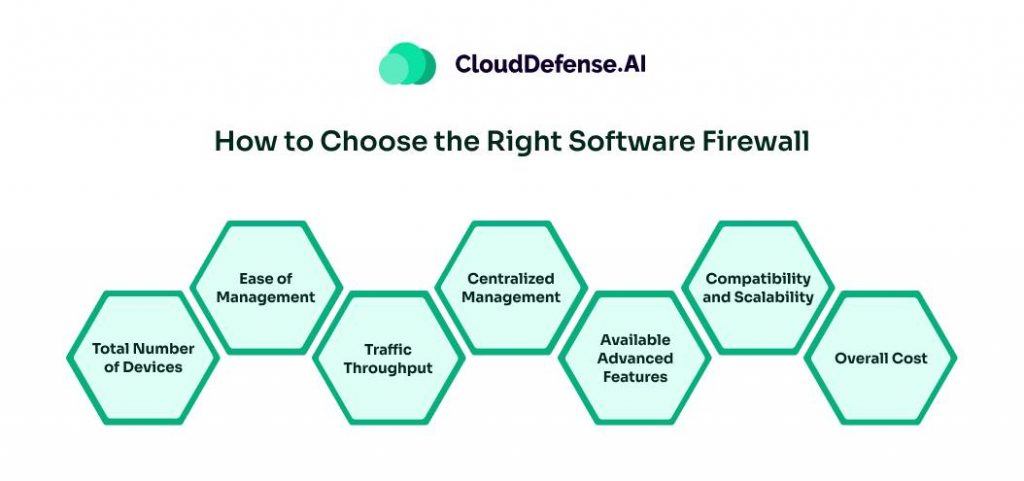
Software firewalls serve as a crucial pillar of any modern network security so one needs to carefully choose it for their organization. Here are certain factors you should consider when choosing a software firewall:
Total Number of Devices
When choosing a software firewall, evaluate the number of devices connected to the network. Software firewalls work well with a decent number of devices but as the network grows, it can become difficult to maintain optimum protection across the network.
Ease of Management
A software firewall will serve your organization efficiently when it is easy to configure, monitor, and manage. So always look for a software firewall that offers ease of management and doesn’t require a huge learning curve to operate.
Traffic Throughput
Another factor you need to consider is network traffic volume while choosing the right software firewall for your organization. The security team needs to accurately estimate the maximum traffic volume so that the firewall doesn’t cross the maximum throughput figure. When a firewall reaches maximum throughput it leads to high latency in the network.
Centralized Management
Ensure the software firewall comes equipped with centralized management as it will make it easy for the security team to update security policies to all the devices. Having centralized management will also enhance threat visibility by covering all the network assets and help enhance the network security posture.
Available Advanced Features
In modern times where threat actors are coming up with advanced cyber attacks, network security must be upgraded to safeguard from all types of attacks. It would be an added advantage to consider a software firewall that comes with a threat intelligence database, machine learning, artificial intelligence, IoT protection, deep packet inspection, and others.
Depending upon your network security requirement, you should consider the advanced features as it will increase the operation cost and bandwidth requirement.
Compatibility and Scalability
Not all software firewalls are designed to be compatible with all types of devices connected to the network. You need to consider a software firewall that integrates well with all your organization’s devices and network without requiring any complex configuration. It is also important to consider the scalability aspect of the firewall because your organization will grow gradually with time.
Overall Cost
The software firewall you would choose must fit the estimated budget of your organization. If you have a sufficient budget, then a stateful firewall with advanced features will be suitable for you. However, the number of advanced features you will choose will decide the overall operation cost. If you have a low budget, then you consider going for free software firewall solutions that may not be highly effective but filter traffic in a simple way.
How Software Firewall Can Enhance the Organization’s Security Posture
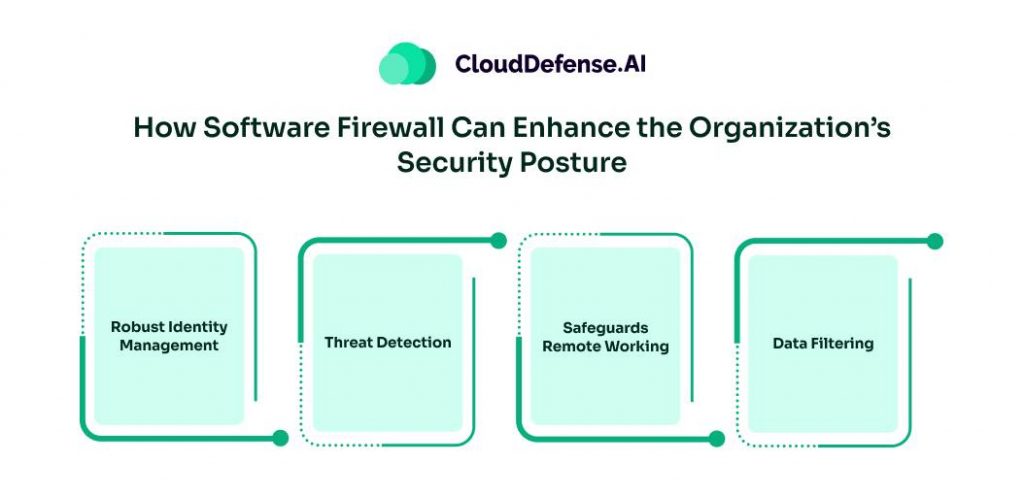
When it comes to improving the security posture, a software firewall plays a crucial role in the organization as it secures a lot of aspects. Let’s take a look at the ways:
Robust Identity Management
Software firewalls integrate the IAM management of your organization to accurately deny any malicious access request while allowing authorized IP addresses. This integration enhances the overall security posture by a large margin as it lets through all the approved users while preventing the access of attackers.
Threat Detection
Another way software firewalls aid an organization’s security infrastructure is by leveraging packet filtering to identify security threats in the network. Some of the advanced software firewalls can even assess the packet contents and identify unusual behavior to flag off the packet. When a threat is detected, it quickly generates an alert for the security team to ensure a quick mitigation process.
Safeguards Remote Working
Nowadays a lot of organizations have adopted work from home where employees work on the organization’s devices from a remote location. Since all these devices are connected to the primary network, it becomes necessary to have a security firewall.
Software firewall fills that gap as it can be installed on that device and used for filtering all the traffic. Software firewall covers all the remote connections wherever the user moves without having to compromise protection.
Data Filtering
A software firewall comes equipped with the capability to monitor and filter outgoing data from the network. It can prevent any sensitive information from going out of the network which can severely compromise the security of the organization. Security teams can also set policies where the firewall will prevent access to websites that are the breeding ground of malware.
Network Threats That Make Software Firewall Necessary for Organizations
In the current scenario where threats are evolving rapidly and virtualization is becoming prominent, numerous network security threats are coming up. However, these threats can’t be solved with traditional solutions and you need a software firewall to mitigate the issues. Here are some prominent network security threats:
Blurring Security Perimeter
Nowadays, every organization is operating in a hybrid or multi-cloud environment which is making it difficult for security teams to define the security perimeter.
Moreover, most of the architecture is based on the cloud that is run by different cloud service providers, leading to a continuous to and from of data across the network. Software firewall helps in defining that security perimeter in a modern cloud environment and filters the traffic.
Evolving Threat Landscape
With time the threat landscape is evolving rapidly and every organization is facing cyber threats in one way or another. Whether it is a small business or a large enterprise, almost 40% of organizations in the world have been affected by data breaches.
So it becomes important for every organization to adopt security firewalls that prevent the outgoing of sensitive data and entry of malicious traffic.
Disparity Between Network and Cloud Teams
As more organizations are shifting to the cloud, security is becoming less important, especially for application development. Most of the developers are leaving vulnerabilities in their code to accelerate their development process.
As a result, network security is often overlooked at the early stage and mostly involved late in the development lifecycle. If the network security team makes any recommendation, they will have to show proof that it won’t slow down the process.
That is why organizations are implementing software firewalls that negate disparity by enabling the network team to monitor all the incoming and outgoing traffic from the application.
Wider Threat Surface
Many modern applications are hosted on virtualized machines and run on a public cloud using Kubernetes and container orchestration. However, this shift from data center to public cloud and interconnection in the architecture has led to a wider threat surface. Traditional firewalls can’t secure connections as most applications are hosted on virtual machines and not local servers, making software firewalls ideally suitable.
Cloud-Native Orchestration Leads to Network Security Challenges
Developers are nowadays using vendor-specific orchestration services to automatically deploy their applications. They just upload the application code and the rest is taken care of by cloud-native orchestration services. However, it leads to network security issues in multi-cloud architecture.
Final Words
For most modern organizations operating in the cloud and adopting a work-from-home model, a software firewall has become an effective choice as it lets secure all the devices connected to the network. With the same motive as a hardware firewall, it efficiently safeguards all the devices as well as the network from internet-borne threats.
It offers granular level control and high feasibility which makes it easy to manage in today’s complex network security. In this guide, we have delivered all the possible information that will provide you with a deep understanding when you ask yourself “What is firewall software”.







